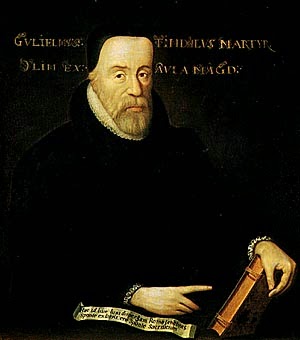William Tyndale (1494-1536) Biblical translator and martyr; born most probably at North Nibley (15 miles south-west of Gloucester), England, in 1494; died at Vilvoorden (6 miles north-east of Brussels), Belgium, Oct. 6, 1536. Tyndale was descended from an ancient Northumbrian family, went to school at
Oxford, and afterward to Magdalen Hall and Cambridge
Tyndale was a theologian and scholar who translated the Bible into an early form of Modern English. He was the first person to take advantage of Gutenberg’s movable-type press for the purpose of printing the
scriptures in the English language. Besides translating the Bible, Tyndale also held and published views which were considered heretical, first by the Catholic Church, and later by the Church of England which was established by Henry VIII. His Bible translation also included notes and commentary promoting these views. Tyndale's translation was banned by the authorities, and Tyndale himself was burned at the stake in 1536, at the instigation of agents of and the Anglican Church.
Tyndale enrolled at Oxford in 1505, and grew up at the University. He received his Master’s Degree in 1515 at the age of twenty-one! He proved to be a gifted linguist. One of Tyndale’s associates commented that Tyndale was “so skilled in eight languages – Hebrew, Greek, Latin, Spanish, French, Italian, English, and German, that whichever he speaks, you might think it his native tongue!” This gift undoubtedly aided him in his successful evasion of the authorities during his years of exile from England
Around 1520, William Tyndale became a tutor in the family of Sir John Walsh, at Little Sodbury in Gloucestershire. Having become attached to the doctrines of the Reformation, and devoted himself to the study of the Scriptures, the open avowal of his sentiments in the house of Walsh, his disputes with Roman Catholic dignitaries there, and especially his preaching, excited much opposition, and led to his removal to
London (about Oct., 1523), where he began to preach, and made many friends among the laity, but none among church leaders.
A clergyman hopelessly entrenched in Roman Catholic dogma once taunted Tyndale with the statement,
william tyndale was burned at the steak for translating the bible from latin to english and other scriptures.
“We are better to be without God’s laws than the Pope’s”. Tyndale was infuriated by such Roman Catholic heresies, and he replied, “I defy the Pope and all his laws. If God spare my life ere many years, I will cause the boy that drives the plow to know more of the scriptures than you!”






